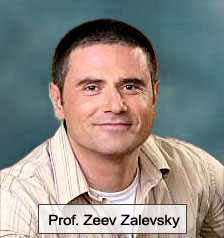Whether it’s creating a bionic contact lens to help the blind see or developing an optical heartbeat monitor, Prof. Zeev Zalevsky enables people to see the world in a whole new way. Prof. Zalevsky, head of the Electro-Optics track at the faculty of Engineering and Director of the Nano Photonics Center at the Institute of Nanotechnology and Advanced Materials (BINA), is one of Israel’s most prolific inventors, with more than 50 patents registered in his name.
His applicable research focuses on the creation of ultra-small applications that harness the power of light for high-speed information processing, medicine and super resolved imaging.
Opening Up the World to the Visually Impaired
 He has developed an optical-fiber based “nano-probe” for use in neuroscience research. This device transmits light and electrical signals, which may be collected from activity centers in the brain, allowing for the exact characterization of neurological structures involved in vision.
He has developed an optical-fiber based “nano-probe” for use in neuroscience research. This device transmits light and electrical signals, which may be collected from activity centers in the brain, allowing for the exact characterization of neurological structures involved in vision.
The insights he gained from this research helped with his development of a new concept allowing blind people to “see” through tactile stimulation of their cornea. This “bionic contact lens” works through the mounting of a camera on top of spectacles, which processes digital images and translates them into tactile sensations.
These sensations can be felt on the person’s cornea, allowing him or her to form a picture of their physical surroundings. This research activity is done in collaboration with Prof. Michael Belkin of Sheba Medical Center at Tel Hashomer. Preliminary clinical trials have been conducted, and the lens is now set to undergo testing.
“It’s like reading Braille, not with your fingertips but with your eyes,” says Zalevsky. He adds, “This technology is good news for humanity, especially in bringing sight to people blind from birth without requiring surgery or damaging other vital senses or organs.”
Creating a Device to “See” Your Blood Pulse and Pressure
Another major invention that has brought Zalevsky acclaim is the device he developed to “see” your blood pulse and pressure, glucose level and even the shape and beat of your heart. He explains that after all, everything is vibrating (one’s glucose level, for example, affects the viscosity of the blood stream which in turn changes the way the arteries vibrate).
When asked why we need additional technology to monitor bodily functions, Zalevsky gives an example from a hospital operating room. “You get a spaghetti effect of wires,” he explains. “Patients have too many machines connected to them, which makes it much more difficult to move them around during the operation or to read the relevant information on time.”
Zalevsky says this fundamental technique can be used to create an entire range of devices. Remotely monitoring every patient in a hospital room or keeping tabs on a person’s vital signs in the operating theater would be child’s play. It would be possible to produce “optical cardiograms” by measuring a person’s heartbeats from a distance. A handheld version that monitors vital signs from a distance could come eerily close to the very popular medical “tricorder” in Star Trek. With engineers like Prof. Zalevsky, it seems the future is already here!
To learn more about Prof. Zalevsky’s research to help the blind see, call Howard Charish at 212-906-3900.


